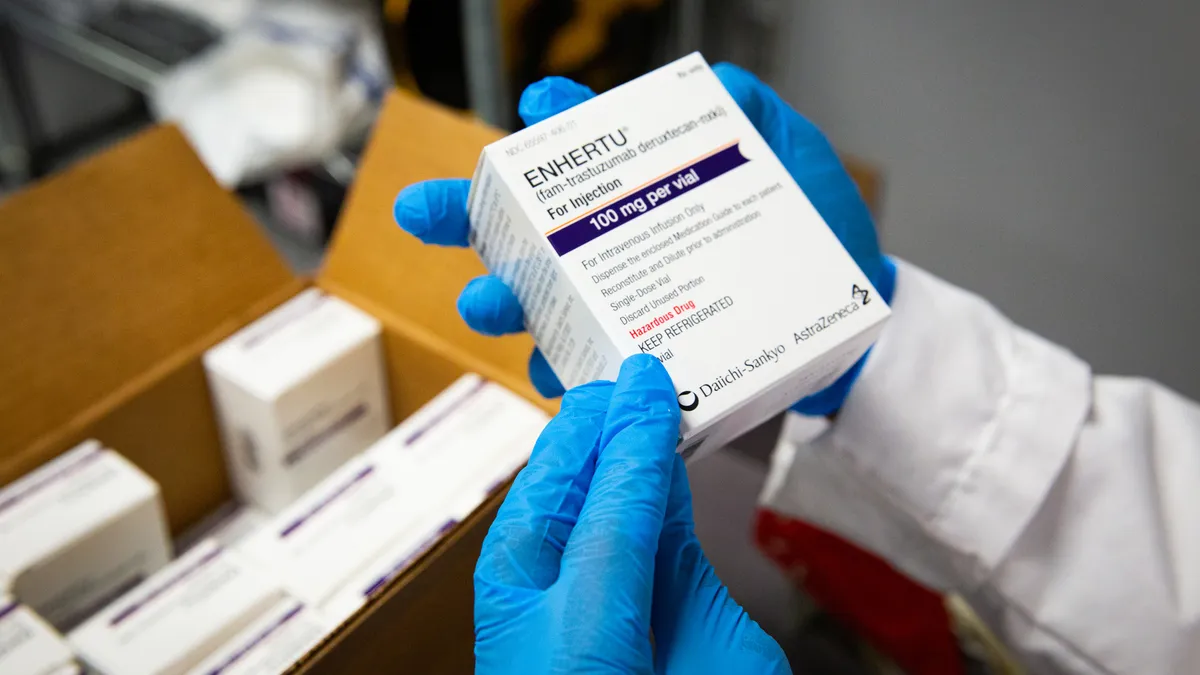THE INDUSTRY’S CHAMPION
BY KIM RIBBINK
After a weighty career in politics and the law, and now seven years into his leadership position at the Pharmaceutical Research and Manufacturers of America, Alan F. Holmer is positioning the organization to address criticisms of the industry and convey to the world at large the benefits that drug manufacturers have achieved in saving lives and enhancing the quality of life.
“I had spent my entire career preparing for the job at PhRMA.” That’s how Alan Holmer describes his experience before taking on the top job at the Pharmaceutical Research and Manufacturers of America. The president and CEO of PhRMA finds both challenges and rewards in his position, but this is a role that Mr. Holmer is more than qualified to fill.
An early introduction to politics through his father, years of experience in the political arena — serving senators, the White House, as well as various government departments — and in depth experience as a tax lawyer and later as an international trade lawyer representing, among other clients, the Pharmaceutical Manufacturers Association, now PhRMA, give Mr. Holmer the grounding he needs to represent the pharmaceutical industry.
In his seven years at PhRMA, Mr. Holmer has done much to raise the profile of the organization as an advocate and lobbying body. His efforts are instrumental in positioning PhRMA to counter the industry’s critics. In spite of PhRMA’s many successes, challenges remain, including further bolstering the industry’s image in the face of very public attacks from congressional representatives and negative media coverage.
To meet these challenges, Mr. Holmer draws on the advice and ideas of his staff, the collective strength of the industry, and his own experiences.
BOX:
Alan Holmer’s efforts are instrumental in positioning PhRMA to counter the pharmaceutical industry’s critics.
BOX:
Bringing it All Together
IN AN EXCLUSIVE INTERVIEW WITH PHARMA VOICE, ALAN F. HOLMER, PRESIDENT AND CEO OF THE PHARMACEUTICAL RESEARCH AND MANUFACTURERS OF AMERICA,TALKS ABOUT HIS DEEP APPRECIATION OF THE PHARMACEUTICAL INDUSTRY AND HIS VISION FOR BRINGING ALL HEALTH CARE ADVOCATES TOGETHER.
CAN YOU TALK ABOUT SOME OF YOUR ACHIEVEMENTS AT PhRMA OF WHICH YOU ARE MOST PROUD?
Last year, I did a five year retrospective on where PhRMA was compared with where the organization had been five years before. PhRMA has grown significantly — in terms of numbers of people and resources — and is much more effective as an advocacy organization today. Our critics often sum up best what strong advocates we are. Senator Charles Schumer, who sponsored a bill in 2002 that would have reduced the incentives for pharmaceutical innovation, attributed to PhRMA the fact that the bill was not enacted. He said, “Obviously, if there were no PhRMA, this bill would be law by now.PhRMA pulls out all the stops.”
WHAT MOST INSPIRES YOU ABOUT THE PHARMA INDUSTRY?
What the industry has done for my children.My son and daughter both have cystic fibrosis and take medicines that are inhaled into their lungs, one of which is Pulmozyme, which is manufactured by Genentech. Pulmozyme helps to liquefy the mucus in the lungs so germs don’t as readily become trapped there; this allows patients to breathe better so they can live better. My son takes an inhaled antibiotic called TOBI, which is manufactured by Chiron. These medicines have had a huge impact on my children’s health and the quality of their lives. When our son was diagnosed with cystic fibrosis on March 15, 1980, my wife and I were told that his likely life expectancy was going to be about 18 years. But through the grace of God, terrific medical care, the help of the pharmaceutical industry, and some luck he’s now in his early 20s. He teaches English and religion at DeMatha High School in Hyattsville, Md.,has been an outstanding athlete,and his lung function is more than 90% of normal.My daughter also is doing very well. She is 20 and is a sophomore at West mont College in Santa Barbara, Calif.
YOU SERVE ON THE COUNCILS AND BOARDS OF A LARGE NUMBER OF HEALTHCARE AND PHARMACEUTICALORGANIZA TIONS. HOW IMPORTANT ARE THESE ROLES IN MAINTAINING A BROAD PICTURE OF INDUSTRY CHALLENGES AND ACHIEVEMENTS AS A WHOLE?
In the pharmaceutical industry generally,too often we spend too much time talking to each other,and it’s very important we spend time talking to other stakeholders in the healthcare community.For example,recent ly I spent three hours at the National Health Council,which is an organization that brings together representatives from a wide variety of voluntary health agencies such as the American Heart Association, the Epilepsy Foundation, and other similar organizations. Having a broad perspective about how others perceive the pharmaceutical industry and what their priorities are in terms of a patient centered healthcare system is very beneficial.
WHAT LED TO YOU BEING THE RECIPIENT OF THE 2001 MARRIOTT LIFETIME ACHIEVEMENT AWARD PRESENTED BY THE ARTHRITIS FOUNDATION? AND HOW MUCH DOES THAT AWARD MEAN TO YOU PERSONALLY AND AS HEAD OFPhRMA?
I was very pleased to accept that award,not on behalf of myself,but on behalf of the industry that I’m privileged to represent in Washington, D.C. Our companies have a number of medicines on the market for arthritis and have many other medicines that are in the pipeline.
CHART:
ENACT A COMPREHENSIVE PRESCRIPTION DRUG BENEFIT IN MEDICARE.
A marketbased drug benefit that gives beneficiaries a choice of competing privatesector plans will provide high quality healthcare and affordability without compromising medical innovation.
AVOID NEW PHARMACEUTICAL PRICE CONTROLS.
As the experience in Europe and Japan shows, price controls stifle innovation and compromise patient access to effective new medicines.
MAINTAIN THE HATCH WAXMAN ACT BALANCE.
This essential mechanism helps achieve a balance between the generic and innovator drugs that work for patients. Upsetting the HatchWaxman balance is unnecessary because competition in the drug market is already strong.
SUPPORT COST CONTROL STRATEGIES THAT DONOT ARBITRARILY RESTRICT DRUG ACCESS. Instead of focusing on reducing the prescription drug line item,some health plans are emphasizing disease management programs, which recognize the value of medicines in both improving patient care and offsetting other healthcare expenditures.
MAINTAIN A STRONG INDUSTRY/ GOVERNMENT PARTNERSHIP FOR RESEARCH.
In particular, current patent policy for federally funded ideas and established mechanisms for cooperative public/ private research has hastened commercialization of technologies that otherwise might never have been used.
MAINTAIN RIGOROUS,EFFICIENT, AND TRANSPARENT REGULATION OF PHARMACEUTICALS. The landmark FDA Modernization Act of 1997 was a major step forward in enabling safe and effective new drugs and biologics to be made available sooner to patients, and FDA must continue to streamline its operations.
RECOGNIZE THE VALUE OF PHARMACEUTICALS.
Prescription drugs save lives, alleviate suffering, and improve the quality of life. They also often reduce the need for other more invasive and expensive treatments. A narrow focus on the cost of drugs, without regard to their value and their role in the health system as a whole, would discourage innovation.
STRENGTHEN INTELLECTUAL PROPERTY PROTECTION AROUND THE GLOBE.
Establish the legitimacy of intellectual property protection for medicines in all countries of the world.
ELIMINATE TRADE BARRIERS.
Reduce foreign government actions that deny their patients access to lifesaving, life enhancing innovative medicines through bans on information and through trade barriers that limit market access.
PROMOTE SOUND SCIENCE IN INTERNATIONAL REGULATORY POLICIES.
Eliminate nontransparent regulatory procedures that substitute political opinion for sound science. I’ve spent my entire career preparing for the job at PhRMA.
PROMOTE SOUND HEALTHCARE SYSTEMS WORLDWIDE.
Clarify the importance of a sound healthcare system in ensuring healthy workers abroad — a vital element for sustained economic development.
Source:Pharmaceutical Research and Manufacturers of America
The Road to Washington
From a very early age, Mr. Holmer has been groomed for a life in public service. His father, Freeman Holmer, a political science professor at Willamette University in Salem, Ore., became state budget director when a fellow professor and close friend, Mark Hatfield, became governor of Oregon. “There were lots of discussions about government and politics when I was growing up,” Mr. Holmer says. “My dream then was to one day be governor of Oregon.”
Among those his father got to know as a professor was his student, Bob Packwood, who later went on to be a U.S. senator. Senator Packwood was a huge influence on the young Alan Holmer’s life and career. With his heart set on public service, Mr. Holmer went to Prince ton University to study politics, and in the summer of his junior year, he went to work for Senator Packwood, then a junior member of the U.S. senate. After graduating, Mr. Holmer began working full time for Senator Packwood.
“I’d been on his staff for about eight months when he made me his chief of staff at the age of 22, which is kind of crazy looking back on it,” Mr. Holmer says.
Senator Packwood ultimately became chair man of the Senate finance committee, which has jurisdiction over Medicare, Medicaid, and all international trade issues. During his six years in that position, Mr. Holmer attended law school at Georgetown University at night. Then, to gain some hands on legal experience, he took a position as an associate working on tax issues at the Washington, D.C.based law firm, Steptoe and Johnson.
Three years later, in 1981, Mr. Holmer was given the opportunity to go to the White House. He worked for the Reagan administration as deputy assistant to the President for intergovernmental affairs, which essentially meant being a liaison with state and local officials across the country. “When I became president of PhRMA, this experience was very helpful; I had the opportunity to work with governors, state legislators, mayors, and county officials during my time at the White House,” he says.
Perhaps most importantly, the two years in the Reagan administration gave Mr. Holmer insight into how to influence policy makers most effectively. From there, Mr. Holmer was named deputy assistant secretary for import administration at the Commerce Department, with responsibility for administering the U.S. antidumping and countervailing duty laws. Two years later, he joined the U.S. Trade Rep resentative’s office as general counsel to Trade Representative Clayton Yeutter, rising to the rank of deputy U.S. trade representative (with rank of Ambassador) after two years.
During this tenure, Mr. Holmer had responsibility for two major legislative initiatives — the U.S.Canada free trade agreement and the 1988 trade bill, The Omnibus Trade and Competitiveness Act.
From the trade representative’s office, Mr. Holmer joined the Washington, D.C., office of the Chicagobased law firm Sidley &Austin as cochair of the international trade practice, which broadened his perspective to a range of industries and gave him a different view of how to lobby Congress and the executive branch.
As Mr. Holmer continues his efforts to lobby Congress, among others, on behalf of the pharmaceutical industry, he taps into his vast experiences in facing such groups.
“During my time at the Commerce Department and the U.S. Trade Representa tive Office, I testified before congressional committees more than 50 times and devel oped very strong relationships with members and staff on both sides of the political aisle, especially on the Finance Committee and the House Ways and Means Committee,” he says.
Curing the Industry’s Ills
As many industry leaders have told PharmaVOICE, one of the most pressing con cerns that pharmaceutical companies face is the battle with poor public image. It is both the mission and responsibility of PhRMA, as well as the goal of Mr. Holmer, to counter criticisms of the industry.
During the past year, Mr. Holmer and his colleagues at PhRMA have increasingly been on the offensive, rather than defensive. For example, Mr. Holmer counters claims that the high cost of drugs is making healthcare unaf fordable, pointing to a government study showing outpatient prescription medicines accounted for only 9.9% of total healthcare costs in 2001.
In a speech to the International Federation of Pharmaceutical Manufacturers Association in Berlin in October 2002, Mr. Holmer laid out seven principles of strategic communica tions and public affairs that PhRMA is imple menting. The first is communicating the prac tical steps the industry is taking to improve access to medicines and improve interactions with healthcare professionals, such as the Code of Interactions for Healthcare Professionals. The second step is to anticipate issues and address them early. Third is to get the message out to critics and allies alike about the indus try’s propatient, proinnovation objectives. Fourth, PhRMA’s goal is to ensure it is nimble and persistent and that it develops allies who share the industry’s objectives. The fifth goal is to raise the tone of the debate and ensure the messages, policies, and practices are sound and benefit patients. Sixth, PhRMA is working to be consistent in its messaging about the value of research, the industry’s dedication to cures, and ensuring people have access to new medicines. And the seventh goal PhRMA has set for itself is to be relentlessly creative.
Mr. Holmer says going forward the goal is to turn what one PhRMA board member labeled “the cycle of doom” into a “cycle of hope,” which was the underlying theme of his speech at PhRMA’s annual meeting this March.
“The `cycle of doom’ starts with the claim that rapidly increasing drug costs are making healthcare unaffordable, bankrupting America, and ruin ing the competitiveness of American business es,” he said in his address. “Doomsayers assert that drug costs are rising because pharmaceu tical companies are getting doctors to pre scribe — and patients to take — new, more costly medicines they don’t need. And that because of pharmaceutical marketing, drug costs are going up 20% per year. Our critics say that like it is one word — drug costs are going up 20% per year — and so the cycle continues. As an industry, our task is to replace the cycle of doom with the cycle of hope.”
The cycle of hope, Mr. Holmer says, “starts with the recognition that as medicines improve and increasingly treat underlying diseases and not just symptoms, medical care improves with greater use of such medicines. With these changes, more Americans are getting earlier and better treatments for diseases that once con signed them to an invariable downward spiral of disability and death. The benefits grow as we tell doctors and patients — including millions of previously untreated or undertreated patients — about new medicines, allowing patients to avoid or reduce hospital izations, lost time at work, and suffering. The cycle of hope continues as part of the return on investment in each medicine is plowed back into research, giving us the opportunity to make more progress against disease, more improvements to healthcare, and new possibilities for patients.”
“The cycle of hope means that medicines are a growing share of the healthcare dollar,” he continues. “The alternative is stagnation. For instance, spending on medicines would be lower without the Alzheimer’s drugs that delay nursing home admissions. But then we’d spend more on nursing homes. Not a good trade. And when we invent the even bet ter Alzheimer’s medicines that we need, spending on drugs will go up some more. That’s a big problem if you believe in the cycle of doom. It’s exactly what should happen if you believe in the cycle of hope.”
In his interview with PharmaVOICE, Mr. Holmer points to medicines for the treatment of diabetes as another example of the advances made by the industry. “As a society, Americans are becoming more and more overweight, and there has been a significant increase in the num ber of Americans with diabetes,” he says. “In the last decade, spending on medicines to treat diabetes skyrocketed from $1.3 billion to $7.3 billion. That’s a 455% increase in one decade. More than threequarters of this increase went to newer oral medicines. Our critics would say, we can’t possibly afford a 455% increase in spending on diabetes medicines.”
But Mr. Holmer contends that those who look at the facts will see at work the cycle of hope, rather than the cycle of doom.
“Spending has increased in part because the number of patients diagnosed with diabetes increased by almost half over the past decade,” he says. “We’re treating far more patients. We’re treating them earlier and more aggres sively, since we now know that keeping blood glucose levels lower and more tightly con trolled slows or avoids the progression of this disease’s terrible complications.
“As we’ve gained better understanding of diabetes, we’ve brought five new classes of medicines to patients since 1995,” he continues. “These medicines greatly expand treat ment options, allowing physicians to better tailor treatment to individual patients’ needs. Increased spending on medicines for diabetes patients can help achieve overall savings on their health costs and avoid hospitalizations. The cycle of hope continues as America’s phar maceutical companies work toward a cure for diabetes. Today, there are many new pharma ceutical treatments in development, ranging from inhaled forms of insulin that would not require injections; to compounds that modify the metabolism of fat cells; to proteins that promote increased insulin production when blood sugar levels are high; and much more.”
Mr. Holmer recognizes the challenges the industry faces in winning the publicaffairs war, telling PhRMA executives that there is “no silver bullet that will allow us to replace the paradigm of doom with our vision of hope.”
“Some look at the increasing use of medicines and the shift to newer medicines as problems to be solved, not solutions for patients and contributions to affordable healthcare,” Mr. Holmer said in his annual address. “They don’t want to acknowledge the data showing that even wellinsured patients underuse asthma medicines and antidepressants. They don’t want to focus on the need for more use of medicines to treat heart disease, hypertension, and other conditions. These are facts that we need to drive into policy debates. There are a number of broken axles in our healthcare system; the modern miracle of pharmaceuticals isn’t one of them.”
CHART:
Advocating a Path
ALAN HOLMER — RESUME
1996-PRESENT. President and CEO, the Pharmaceutical Research and Manufacturers of America, Washington, D.C. PhRMA represents the country’s leading researchbased phar maceutical and biotechnology companies, which are investing more than $30 billion in 2003 alone in the quest for new medicines.
1989-1996. Cochair of the international trade practice for the law firm Sidley & Austin, Washington,D.C. 1985-1989. General Counsel to U.S. Trade Representative, Washington, D.C. Promoted to Deputy U.S.Trade Representative (with rank of Ambassador) in 1987.
1983-1985. Deputy Assistant Secretary for Import Administration at the Commerce Department,Washington,D.C.
1981-1983. DeputyAssistant to the President for Intergovernmental Affairs,Washington,D.C.
1978-1981. Associate, focused on tax issues,Steptoe and Johnson,Washington,D.C.
1972-1978. Chief of staff to Senator Robert Packwood,Washington,D.C.
1971. Legislative Assistant to Senator Packwood,Washington,D.C. EDUCATION.
1978. Law degree, Georgetown University Law Center,Washington,D.C.
1971. Honors graduate,Princeton University,Princeton,N.J. AWARDS
2001. Marriott Lifetime Achievement Award presented by the Arthritis Foundation
1998. Yetta Rosenberg Humanitarian Award
1992. Distinguished Community Service Award,Princeton Club of Washington,D.C.
BOX:
PhRMAHead Calls for “Right Kind”of Drug Benefit This Year
In January of this year, Alan F. Holmer, president and CEO of the PharmaceuticalResearch and Manufacturers of America (PhRMA), told the Epilepsy Foundation that PhRMA continues to strongly support a Medicare prescription drug benefit plan — one that covers all seniors and the disabled and relies on marketbased solutions to keep costs down — and urged the new Congress to pass a plan this year. While not endorsing any specific legislation, Mr. Holmer said the key ele ments of a bipartisan Medicare prescription drug plan should: .
- Ensure all seniors have access to the medicines they need;
- Promote choice;
- Rely on the private sector to promote competition;and
- Respect the doctorpatient relationship.
“America’s seniors deserve access to the best medicines we can invent,” Mr. Holmer says. “That’s why PhRMA is working to help enact prescription drug coverage that gives all Medicare beneficiaries the same kind of quality, private market drug coverage that 150 million other Americans — including members of Congress — now enjoy.”
Mr.Holmer also pointed out that aMedicareprescription drug ben efit shouldhelp states with their budget problems by paying for much of the drug costs of the7 million seniors eligible for both Medicareand Medicaid.According to the Congressional Budget Office,these savings would reach an estimated $41 billion between 2005 and 2012.
“Prescription medicines make up only 10 cents out of the health care dollar,” Mr. Holmer says. “When you consider this, prescription drugs are an extraordinary value.”
He cited examples of drugs that help more than a million epilepsy patients control their seizures, protease inhibitors that have helped reduce AIDS deaths in the United States by 80%,cholesterollowering drugs that are preventing thousands of heart attacks each year, and medicines that allow children with asthma to breathe freely and go to school, rather than to the emergency room.
It is both the mission and responsibility of PhRMA, as well as the goal of Mr.Holmer, to counter criticisms of the industry. There are a number of broken axles in our healthcare system;the modern miracle of pharmaceuticals isn’t one of them.
Making Sense of it All
According to Mr. Holmer, it makes no sense for pharmaceutical companies to discover and develop new medicines if doctors and patients don’t know they exist.
“That’s why we work to inform doctors about treatment options,” Mr. Holmer said during his address. “We also share information about our products directly with consumers. Consumer health information on pharmaceuti cals has brought millions of patients into need ed medical care, according to research by the FDA and others. It also enhances patients’ com pliance with physiciandirected treatment. Despite these proven successes, our industry’s product advertising is often criticized in the United States. And it’s just plain forbidden in Europe, where governmentrun health systems have adopted a policy of `don’t tell, don’t ask’: Don’t tell patients about innovative medicines and they hope that patients don’t ask.
“We fight for consumer health information so that all patients can get the best medicines their doctor prescribes for them with their unique medical needs,” Mr. Holmer adds. “It’s time for us to stop just defending promotion and to start calling on its critics to explain their opposition. For example, the critics should explain either that they prefer millions of patients remain untreated, or just what is their different and better way for helping them. I’ll bet their alternative has three hallmarks: more government, restricted information, and little patient choice.”
The choice may be clear to Mr. Holmer, but his organization still faces opposition from industry critics, even in light of PhRMA’s establishing guidelines that outline acceptable interaction procedures between pharmaceutical companies and healthcare providers.
After months of discussions with pharma ceutical executives, PhRMA last year intro duced the Code of Interactions for Healthcare Professionals. Some critics, however, have raised concerns about the fact that the code is voluntary saying the initiative will only have teeth if it is mandatory. Mr. Holmer rejects that criticism, saying evidence so far shows overall compliance with the code’s objectives.
“As far as I know, every PhRMA company, which is every major pharmaceutical company in America, is implementing the code,” he comments. “And I’m told from a variety of sources that they have seen a significant change in the marketplace as a result of the change in company behavior. So my sense is that the code has been very successful.”
PhRMA also recently recast its strategic and public affairs division in an effort to be more aggressive in addressing indus try critics, rather than letting the media dictate the agenda. “What we want to do is build a public affairs program that real ly takes the initiative in driving messages through the earned media and paid media, and my objective is to reallocate resources so that instead of being on the defense, we spend at least onethird of our time being on the offensive and getting our positive messages out,” he says. “PhRMA needs to make sure that the people in the media and the public understand what’s driv ing healthcare costs — and it is an utterly erroneous message that the cost of drugs is making healthcare unaffordable. We also need to build common ground with a variety of allies and develop longterm committed relationships with patient groups, with doctors, with medical researchers, and with others.”
Among the key initiatives Mr. Holmer and his team are pushing for this year is a Medicare prescription drug benefit plan. “Our top priority at PhRMA is making sure that Congress enacts a meaning ful Medicare prescription drug benefit for seniors and the disabled,” he says.
Moving Forward
Belief in what the industry does and what it is trying to achieve certainly help Mr. Holmer as he and PhRMA strive to put forward the industry’s message. But belief and determina tion alone are not enough to achieve those goals.
Russel A. Bantham, executive VP and chief operating officer of PhRMA, says Mr. Holmer’s greatest gifts are his ability “to lead, establish a vision for an organization, and motivate and empower individuals to be the best they can be. He’s a good judge of character and individuals’ capabilities.”
Others close to Mr. Holmer cite his abilities “in negotiation, in advocacy before the Congress, advocacy generally, and also in bringing people together.”
Mr. Holmer adds, “At PhRMA I’ve hired people who are a lot smarter than I am in their individual areas of expertise. I have given them lots of running room and resources so they can succeed.”
Mr. Holmer has put to good use the lessons he has learned from the influential people in his life. He says Senator Packwood taught him that loyalty in an orga nization shouldn’t only flow from the bottom up but from the top down as well. Malcolm Baldrige, the sec retary of commerce when Mr. Holmer was there, taught him the importance of taking responsibility for mistakes. Those closest to Mr. Holmer — his parents, his older brother, his wife, and his children — have provided him with extraordinarily valuable life lessons.
Mr. Holmer is justifiably proud of his success in improving the effectiveness of PhRMA.
“Seven years ago, I said my goal was to make PhRMA the finest advocacy organiza tion in America, and I believe that we are,” he says. “PhRMA is a model at the international level, at the federal level, and at the state level. There’s no better advocacy organization.”
BOX:
It’s time for us to stop just defending promotion and to start calling on its critics to explain their opposition.I’ll bet their alternative has three hallmarks:more government, restricted information,and little patient choice.
PharmaVoice welcomes comments about this article. Email us at [email protected].
ricted information,and little patient choice.PharmaVoice welcomes comments about this article. Email us at [email protected].















